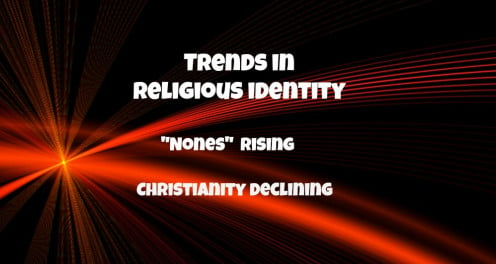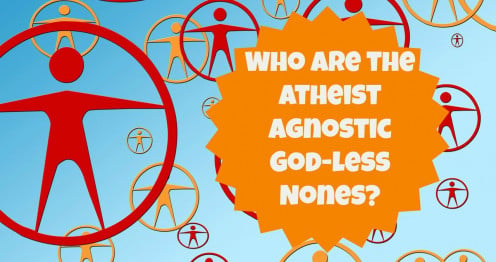Polls Show Christianity Declining, "Nones" Rising
Trends in Religious Identity

Every seven years the Pew Research Center conducts a massive study about religion called “The Religious Landscape Study.” The 2014 Study shows some surprising changes in religion in the United States.
What Does the Pew Survey Tell Us About the Incidence of Various Religions in the United States?
It comes as no surprise that America is overwhelmingly Christian. About seven in ten Americans are Christian.
The big surprise is that in a country that is seen as so religious, almost a fourth of Americans report having no religion.
Incidence of Various Religions in the United States in 2014
Relgiion
| Percent of Population
|
|---|---|
Christian
| 71%
|
Jewish
| 2%
|
Muslim
| 1%
|
Other
| 3%
|
Nones
| 23%
|
On March 24, 2015, CNN aired a documentary, Atheists: Inside the World of Non-Believers. The special began with the narrator saying: “One nation, under God. It’s who we are and religion is what we do.”
Apparently she was wrong. Religion is not what America does; at least, not what all of America does. A substantial proportion of Americans—nearly one fourth--are not affiliated with any religious group. (We’ll look at this in more detail below.)
What Does the Pew Survey Tell Us about Christianity?
Christianity has always been the predominant religion in America. However, Christianity is not as popular as it once was. The proportion of Americans who self-identify as Christian is currently 71%. Seven years ago, it was 78%.
The largest branch of Christianity is “Evangelical Protestants.” About 25% of the United States population is in this group. Catholics account for 21% of the population, and Mainline Protestants account for 15%.
Comparing 2007 to 2014 shows that the Catholics and the Mainline Protestants have lost share and Evangelical Protestants have made a small gain in share.
Christianity Trends
2007
| 2014
| Change
| |
|---|---|---|---|
Christian
| 78%
| 71%
| -7
|
Evangelical Protestant
| 25%
| 26%
| +1
|
Catholic
| 24%
| 21%
| -3
|
Mainline Protestant
| 18%
| 15%
| -3
|
Other Christian
| 11%
| 9%
| -2
|
The reason that Evangelical Protestants are gaining share while other Christian groups are losing adherents is that more people are switching to evangelical faiths from Mainline Protestant and Catholic churches than vice-versa. Thus, Evangelicals gained despite the overall decline in Christianity.
Who Are the "Nones"?

What Does the Pew Survey Tell Us about the Religion-less or “Nones”?
The Pew Research Center uses a shorthand term for the religiously unaffiliated--atheists, agnostics, and people who say their religion is “nothing in particular"—they are lumped together as “Nones.” This group has undergone huge growth since the last survey. In 2007, they were 16% of the U.S. population. In the 2014 survey, they are 23% of the population. It is a whooping 44% increase.
About one in five (18%) of Americans say they were raised in a faith, but now they are a “None.” (There is some movement in the other direction, but it is smaller--4% of Americans who were not raised in any faith joined a faith tradition as an adult. Thus for every one person who comes to faith as an adult, about four people leave their religion.)
There is an increase in share for the “Nones” among both men and women, but men are more likely to be in the “None” category than women. Among men, 27% are “Nones”; among women 19% are “Nones.”
Young people are also more likely to be in the “Nones” category, although the proportion of “Nones” is high among all age groups. Among the youngest age group, the Millennials, over a third--35%-- are classified as “Nones.”
Incidence of "Nones" by Age
Generation
| Date of Birth
| Age Range
| 2007
| 2014
| Difference
|
|---|---|---|---|---|---|
Millennials
| 1981-1996
| 18-33
| 25%
| 35%
| +9
|
Generation X
| 1965-1980
| 34-49
| 17%-
| 23%
| +4
|
Baby Boomers
| 1946-1964
| 50-68
| 14%
| 17%
| +3
|
Silent Generation
| 1928-1945
| 69-86
| 9%
| 11%
| +2
|
The Pew Research Center reports that the growth of the “Nones” is seen among all demographic categories—among men and women, across all racial and ethnic groups, among people with all levels of education and income, among immigrants and the native-born, and throughout all regions of the country, even in the Bible Belt.
The proportion of “Nones” in the United States is likely to continue to rise. First, because there is a clear trend in the direction of no religion among all age and demographic groups. Second, because of generational replacement—the older generation which is more likely to be religious dies off and is replaced by the younger generation which is less likely to be religious.
We also need to consider the “tipping point.” In 2002, Malcom Gladwell published a book titled The Tipping Point: How Little Things Can Make a Big Difference. He demonstrated how an idea, trend, or social behavior makes small gains over time until it crosses a threshold, tips, and spreads like wildfire.
I suspect the “atheist” category is undercounted. There is such a stigma attached to atheism that many people who actually have no belief in God prefer to call themselves agnostic or “not religious.” Consequently, when the acceptance of atheism becomes more widespread, it will fuel an increase in the number of people willing to call themselves “atheist.”
What Does the Pew Survey Tell Us about Godless Americans?
I find the category of “Nones” to be a little misleading. It includes all people with no religious affiliation, but not everyone in this group has actually rejected religion. About 7% of the U.S. population don’t belong to any particular religion, but do feel that religion is important.
Consequently, I created a category of “Godless Americans” --people that call themselves atheist, agnostic, or who say they are irreligious because religion is not important to them.
“Godless Americans” increased from 10% of the total U.S. population to in 2007 to 16% in 2014. That is a fairly large minority group--equal to the proportion of other minority groups in the United States like African- Americans (15%) and Hispanics (16%).
What Does the Pew Survey Tell Us about Atheists/Agnostics?
The atheist/agnostic group differs from all Americans in several ways. They are more likely to be male, more likely to be young, more likely to be white, more likely to have a college education, and more likely to have a household income over $100,000. They are most likely to live in the West and least likely to live in the South.
Demographics of Atheists/Agnostics in the U.S. in 2014
Total U. S. Population
| Atheist/Agnostic
| Difference
| |
|---|---|---|---|
Male
| 48%
| 57%
| + 9
|
Aged 18 to 29
| 20%
| 31%
| +11
|
White
| 66%
| 82%
| +16
|
College degree
| 19%
| 25%
| + 6
|
$100,000+
| 17%
| 22%
| + 5
|
Region
| |||
Northeast
| 18%
| 21%
| + 3
|
Mid-West
| 22%
| 22%
| 0
|
South
| 37%
| 30%
| - 7
|
West
| 23%
| 28%
| + 5
|
Be careful when you read statistics. I saw one article where the author tried to claim that the atheists/agnostics were uneducated because only 25% had a college education. That is true, but what the author was too stupid to see, or was hoping his readers would be too stupid to see is, the population as a whole and the adherents of various religions are even more likely to lack a college degree.
What are the Statistics about Religion Around the World?
The Win-Gallup International poll is a worldwide poll of religiosity. The question asked was ”Irrespective of whether you attend a place of worship or not, would you say you are a religious person, not a religious person, or a convinced atheist?”
Worldwide, 59% are religious, 23% are not religious, and 13% are atheist. The trend has been towards non-religious. In 2012, 68% said they were religious compared to 77% who said they were religious in 2005. The proportion who were convinced atheists was also higher in 2012 vs. 2005 -- 7% up from 4%.
In the United States, 60% said they were religious in 2012 down from 73% in 2005.The proportion who said they were a convinced atheist went up from 2005 compared to 2012 –1% vs. 5%.
Here is the breakout for some of the major countries of the world, from most religious to least religious.
Incidence of Religiosity in Various Countries in 2012
Religious
| Not Religious
| Convinced Atheist
| Don't Know
| |
|---|---|---|---|---|
Global
| 59%
| 23%
| 13%
| 5%
|
Ghana
| 96%
| 2%
| 0
| 1%
|
United States
| 60%
| 30%
| 5%
| 5%
|
Russia
| 55%
| 26%
| 6%
| 13%
|
Germany
| 51%
| 33%
| 15%
| 2%
|
Canada
| 46%
| 40%
| 9%
| 5%
|
France
| 37%
| 34%
| 29%
| 1%
|
Australia
| 37%
| 48%
| 10%
| 5%
|
China
| 14%
| 30%
| 47%
| 9%
|
England is not shown because it was not included in the data. Ghana is shown because it has the highest rate of religiosity. Numbers may not add to 100% due to rounding.
The data also showed some interesting correlations with demographic characteristics. Within each country, the religiosity score was consistently higher among the less educated and the poorer people of each country.
2014 Data for UK
The 2014 Win/Gallup Poll showed 30% of UK citizens said they were religious, 53% said not religious and 13% said they were a convinced atheist. This indicates that the UK is one of the least religious countries in the world.
The Future of Religion

What are Predictions for the Future of Religion Worldwide?
Then Pew Research Center has made some projections about the future of worldwide religiosity in their report, The Future of World Religions: Population Growth Projections, 2010-2050. They looked at current levels of religiosity and made projections based on migration patterns, demographic data, and the patterns of switching faiths among various populations.
Christianity is the largest religion in the world, but Islam is the fastest growing religion. By 2050, the number of Muslims will almost equal the number of Christians. Because of slower population growth in Western nations where atheism is increasing, the larger growth rate in Muslim countries will reduce the proportion of “Nones” worldwide.
The table below shows the proportions of each religion in 2010 and the projections for 2050. Of course, over the next 35 years demographic trends could change resulting in inaccuracies in these projections.
Incidence of Various Religions Worldwide
2010
| 2050
| |
|---|---|---|
Christians
| 31%
| 31%
|
Muslims
| 23%
| 30%
|
Nones
| 16%
| 13%
|
Hindu
| 15%
| 13%
|
Buddhists
| 7%
| 5%
|
Folk Religions
| 6%
| 5%
|
Jews
| 0.2%
| 0.2%
|
Other
| 0.8%
| 0.7%
|
How Do You Feel about the Findings of These Polls?
Is this good news or bad news? It all depends on your point of view about religion in general and religions in particular.
Sources
Pew Religious Landscape Study About 35,000 interviews were conducted between June 1 and September 30 of 2014. The results were compared to the study conducted in 2007.
The Future of World Religions: Population Growth Projections, 2010 to 2050
Take part in the survey.
How would you have answered the WIN-Gallup survey?
An Interview on PBS about the Pew Survey of Religion
© 2015 Catherine Giordano








